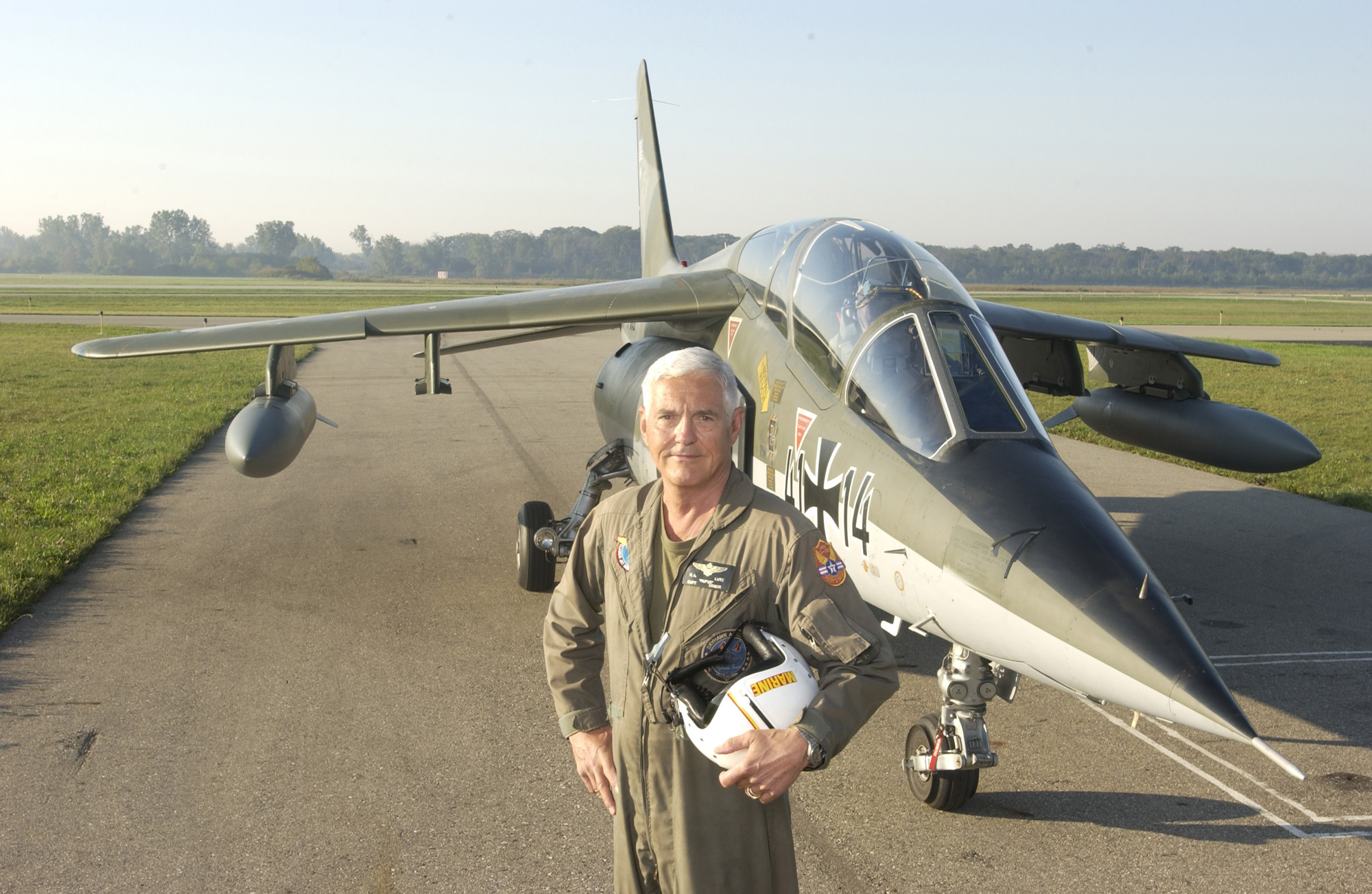The Flying Innkeeper – Barron Hilton
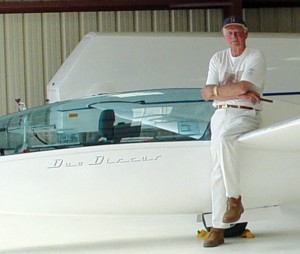 Barron Hilton developed his passion for aviation long before he took the position of CEO, president or chairman (his present title) of Hilton Hotels Corporation. Hilton has more than 7,300 hours in gliders, balloons, helicopters and single- and multi-engine aircraft. It all began when he was about 10, when, while living in Dallas, he began riding his bicycle to nearby Love Field.
Barron Hilton developed his passion for aviation long before he took the position of CEO, president or chairman (his present title) of Hilton Hotels Corporation. Hilton has more than 7,300 hours in gliders, balloons, helicopters and single- and multi-engine aircraft. It all began when he was about 10, when, while living in Dallas, he began riding his bicycle to nearby Love Field.
“I’d go and just stare at those planes and eat my heart out, trying to figure out when I’d be able to fly one,” said Hilton.
Now, Hilton has a choice of flying many aircraft. He shares the passion and fun with friends who visit the Flying M Ranch and Conference Center in northern Nevada, a haven that begins 25 miles south of Yerington, Nev., and stretches to the shores of Mono Lake in California. The location offers some of the best soaring in the world, due to thermal updrafts generated east of the Sierra Nevada range.
Hilton takes advantage of those conditions in his Grob Twin III Acro, a Duo Discus, a Discus B, a Schweizer 2-32 and an ASW-20. A Cessna 185 is used as a tow plane for his gliders. Other aircraft at the ranch include a Bull Stearman, a Citabria Decathlon and an Extra 300. He owns an MC 500-E, and says he bought his first helicopter over three decades ago; he took some training but didn’t get his license until he was about 65.
Visitors also have the opportunity to go up in Hilton’s hot air balloons (at last count, he had three). Frequent quests of the Flying M over the years have included astronauts such as the late Alan Shepard, Gene Cernan and Bill Anders, as well as famed pilots like Cliff Robertson, Bob Hoover, Carroll Shelby, Clay Lacy and Steve Fossett.
Some earn their entry into this paradise by being winners of Barron Hilton Cup competitions. Barron Hilton Cup flights are triangular flights of at least 400K (248.56 statute miles). The points are calculated using a handicap so that sailplanes of all types have an equal chance of winning. Glider pilots who complete the longest triangle flights in each of eight divisions from around the world win a 10-day soaring camp at the Flying M Ranch, where a number of international soaring records have been set.
Read more: The Flying Innkeeper – By Di Freeze
A Calm Voice in the Face of Disaster – Bob Hoover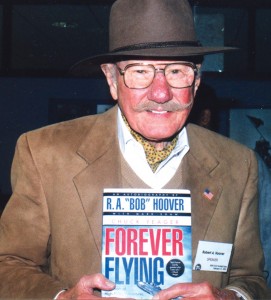
In more than 50 years of flying, Bob Hoover performed aerobatics in more different airplanes, in more events, in more countries, and before more people than anyone in the history of aviation. But he almost didn’t get that chance.
Hoover began flight lessons at 15, and then joined the Tennessee Air National Guard at 18. In September 1940, he went on active duty, and his unit was later meshed into the Army Air Corps.
On Feb. 9, 1944, while leading a flight of Spitfires patrolling the waters off the Italian and French coasts, the 22-year-old pilot shot down his first enemy aircraft, a Focke-Wulf 190. Unfortunately, he was unable to escape the same fate. After being hit himself, a wounded Hoover went down at sea. He floated in the icy water for four hours, before being spotted by Germans on patrol.
After being questioned at the German Luftwaffe interrogation headquarters at Oberursel, Hoover was eventually moved to Stalag Luft I, at Barth. Guards boasted that no one had ever escaped from Stalag 1, but Hoover, who had already made several escape attempts, continued his “obsessive pursuit of freedom.” In April 1945, after being a POW for more than 15 months, Hoover thought chances to escape looked good.
“The guards started deserting, because the Russians were getting closer and closer,” he said. ”
With two partners, he climbed over the barbed-wire fence, while other POWs created a diversion. They made their way across the frigid Baltic Sea on a raft made out of dead wood and grapevines, and then the trio split up. Hoover and one partner continued on together, heading west.
After witnessing various Russian atrocities, the two men came across an abandoned Luftwaffe air base, just inside the border of Germany, deserted except for a few ground crew members. After discovering several Focke-Wulf 190s that were no longer flyable, they eventually came to one that although full of holes, looked capable of flight.
Hoover had never flown a 190, but someone in the camp had, and had shared details with him. As he climbed into the cockpit, it didn’t immediately occur to him that he would be an easy target.
“I opened the throttle full power and went straight out across the grass field without going on the taxiway to the runway,” he said. “I got airborne and pulled the gear up. Then, the stupidity of what I was doing hit me.”
Read more: Bob Hoover: A Calm Voice in the Face of Disaster (3 Parts) – By Di Freeze
What’s Stopping You? – Dee Howard
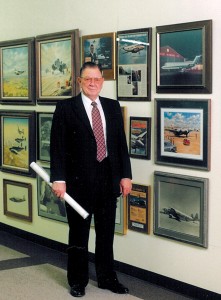 Early in his 50-year history in aviation, Dee Howard came up with a clever advertising slogan: “If you don’t have Dee Howard Thrust Reversers, what’s stopping you?”
Early in his 50-year history in aviation, Dee Howard came up with a clever advertising slogan: “If you don’t have Dee Howard Thrust Reversers, what’s stopping you?”
Howard is internationally recognized for his development and certification of aircraft safety and performance improvements, such as jet engine thrust reversers. It’s obvious that not much has “stopped” him. He has patents for many inventions and has worked with or mentored some of the most well known names in aviation, including James Raisbeck, Ed Swearingen and Bill Lear.
He’s been recognized for his accomplishments in several different ways. In November 2000, he was inducted into the Texas Aviation Hall of Fame. In March 2002, he received the prestigious Charles Taylor Master Mechanic’s Award from the FAA, for more than 50 years of dedicated service. In 2002, at the NBAA Convention, the Nordam Company acknowledged Howard and Etienne Fage (one of the original supersonic Concorde development engineers) for their advancement of jet engine thrust reverser design by announcing the Nordam Dee Howard/Etienne Fage Scholarship Award.
“We had a joint venture on the fan jet engine thrust reversers,” Howard explained of his relationship with Fage. “When I sold the Dee Howard Company, Nordam bought the Dee Howard Thrust Reverser Division. They were so pleased with the advanced technology that they endowed Embry-Riddle with the scholarship.”
Howard, who “took to engineering like a duck to water,” founded Howard Aero, Inc., at San Antonio International Airport in 1947. He got into aircraft manufacturing with the Howard Super Ventura, which set the pace for high-performance executive aircraft. The Howard 250, 350 and 500 models followed.
To read more about Dee Howard’s significant projects, read “What’s Stopping You?” – By Di Freeze
When Opportunity Knocks – Charlie Johnson
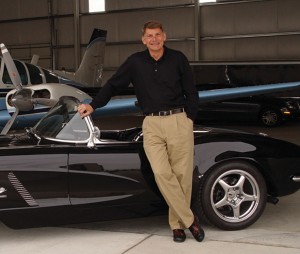 According to Charlie Johnson, life is all about doing things that are fun. That includes riding Harleys and collecting cars, but a huge part of his life is centered on aviation.
According to Charlie Johnson, life is all about doing things that are fun. That includes riding Harleys and collecting cars, but a huge part of his life is centered on aviation.
Johnson’s strange and wonderful career path has taken him from flying F-105 fighters to the very heights of the general aviation industry. When we interviewed the former president of Cessna in late 2004, he was acclimating to being “self-unemployed.” Now, in a surprising turn of events, he’s president of Aviation Technology Group, the manufacturer of the Javelin, a tandem-seat, twin-turbofan executive jet.
Stallion 51 proprietor Lee Lauderback describes Charlie Johnson as pure “fighter pilot.”
“The fighter pilot mold is a special mold,” he said. “Those characteristics never go away. Charlie is fighter pilot from one end to the other. He’s also one of the most professional and skilled aviators I’ve ever had the privilege of flying with.”
Johnson trained as a B-24 navigator at Wright-Patterson AFB, but ended up flying F-105 fighters in some of the world’s most exotic locations, including Okinawa, Thailand and Vietnam, completing more than 100 missions and accumulating 1,000 hours in the “Wild Weasel.”
Once out of the military, Johnson flew a Beech 18 for a company in Wisconsin, before becoming golf legend Arnold Palmer’s chief pilot. He worked for Palmer for three years, until Gates Learjet recruited him. He relinquished his job to Lauderback, and stepped into his role as test pilot in production flight test, and then chief of production flight test. After three years with Gates Learjet, Johnson answered a mysterious phone call, and heard something that sounded like knocking. Thinking it was a bad connection, he started to hang up, but a voice said, “Charlie, don’t hang up! You know what that is? It’s opportunity knocking.”
The voice on the other end belonged to Russ Meyer, chairman and CEO of Cessna.
“He said they had an opening in flight test over at Cessna,” Johnson remembered.
He began working for Cessna in 1979.
To find out how Charlie Johnson rose to the top of Cessna Aircraft Company, and how a life-threatening illness changed his course in life again, read the following: A True “Fighter Pilot” Begins Life Anew – By Di Freeze and Charlie Johnson Named President and COO of ATG
Aviation Multimedia & Software Empire – Martha & John King
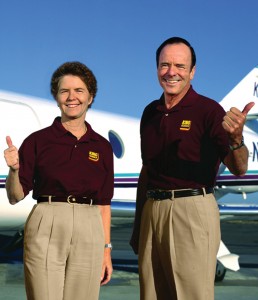 Martha and John King, principals of King Schools, Inc., have built an empire. King Schools is the world’s leading producer of aviation ground school multimedia interactive training videos and computer software, and is responsible for teaching more than half of all the new private and instrument pilots in the U.S.
Martha and John King, principals of King Schools, Inc., have built an empire. King Schools is the world’s leading producer of aviation ground school multimedia interactive training videos and computer software, and is responsible for teaching more than half of all the new private and instrument pilots in the U.S.
Through the school, based in San Diego, the couple has delivered more than five million videos with more than eight million hours of video instruction. In addition, they produce Cessna Aircraft Company’s multimedia flight training system for Cessna Pilot Centers, which span the U.S., Europe, Canada and South America.
The Kings made headlines in general aviation news with their video, “Practical Risk Management for Pilots.”
“If you tell any GA pilot, by and large, that aviation is risky and unsafe, that pilot will argue with you,” said John King. “They’ll tell you, ‘That’s not true; it’s safer than driving.’ It’s not that they’re macho; it’s just that the industry has told this big lie for so long that we believe it.”
Insurance companies believe there is a risk; for the first time in GA history, they’re offering a reduction in premiums with a condition—policyholders take the King course.
“Practical Risk Management for Pilots” is part of the enhanced Safety Rewards Program of insurance giant Avemco, a subsidiary of HCC Insurance Holdings, Inc.
John King said the industry doesn’t have a liability problem; it has an accident problem.
“Our accident rate is unacceptable and must be improved to preserve the future of aviation,” he said. “I don’t believe it’s possible to fly a GA airplane without risk and I think we should not have an Aviation Safety Program; we should have an aviation risk management program.”
He added that the GA industry has been focusing on the wrong thing.
“It focuses on the absence of risk, and there’s no such thing as the absence of risk,” he said.
Eighty-five percent of all GA accidents are due to pilot error, or what he refers to as “failure in risk management.”
Read more: Practical Risk Management for Pilots – By Karen Di Piazza
Largest GA Piston Plane Maker – Alan & Dale Klapmeier
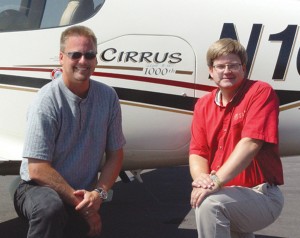 Brothers Alan and Dale Klapmeier, Cirrus Design Corporation cofounders and owners, began their Duluth, Minn.-based company in 1979, when they started to build their kit airplane in their parents’ barn.
Brothers Alan and Dale Klapmeier, Cirrus Design Corporation cofounders and owners, began their Duluth, Minn.-based company in 1979, when they started to build their kit airplane in their parents’ barn.
“After more than 25 years, we’re an overnight success,” laughed Alan Klapmeier, Cirrus CEO, president and director.
In 1999, finally, after enough capital was raised, Cirrus began producing its FAA-certified composite, SR series single-engine piston, four-seat planes, which have built-in parachutes. In 2001, Cirrus captured just 11 percent of the market for single-engine piston planes. But with its easy-to-fly, futuristic, sleek-looking composite design, with an oversized, “swooped-up-angled,” two-door design, it quickly captured the eye of thousands of buyers. Cirrus soon outsold competitor Cessna Aircraft Company and sold more four-seat aircraft than any manufacturer in the world.
Cirrus’ hip-looking planes, with an all-digital glass cockpit, caught the attention of mainstream media, too. TIME magazine said it was “blue skies for Cirrus,” and credited the Klapmeiers with “giving lift to the small-plane industry with an easy-to-fly design.” Forbes said Cirrus sells “meaning.”
Now, the Klapmeiers, both active pilots, have decided to produce a single-engine jet, which will incorporate successful design technologies from Cirrus’ SR22, SR20 and SR22-GTS single-engine piston aircraft.
“Although we haven’t begun the process of a prototype of our jet, I assure you we’re not producing a VLJ,” said Alan Klapmeier. “We’re going to manufacture a ‘personal jet.’
That concept is based on an all-pilot-design aimed for pilots’ comfort. The jet will have controls on both sides of the cockpit, so it could be a two-pilot operation.”
He said Cirrus’ PJ will actually be complementary to current very light jets.
“It will create customers for other aircraft when people move up in type to the Eclipse or the Mustang,” he said.
Now in the initial design phase, Cirrus’ single-engine, turbine, composite jet will include a built-in-parachute.”
“It’s time that someone design a front-left-seat jet, the same concept the company has used for its current composite piston planes, designed with the pilots’ comfort in mind,” he said.
Read more: After 25 Years, Cirrus is an “Overnight Success” – By Karen Di Piazza and Cirrus: A Single Engine Jet – By Karen Di Piazza
The Planes I’ve Flown & The People I’ve Known – Clay Lacy
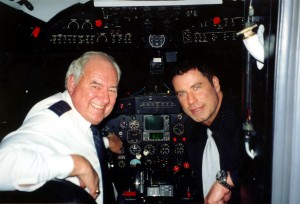 The course of Clay Lacy’s life has definitely held twists and turns, but really, it’s always had one central theme—leading him to say he’s led a very “narrow life.”
The course of Clay Lacy’s life has definitely held twists and turns, but really, it’s always had one central theme—leading him to say he’s led a very “narrow life.”
“It’s always been in aviation,” he explained.
People have told Lacy that if he ever has time to pen his bio, he should name it, “The Planes I’ve Flown and The People I’ve Known.” Why? For one, Lacy, the founder of Clay Lacy Aviation, based at California’s Van Nuys Airport, has flown more than 300 different aircraft types. He has more than 30 different type ratings and holds 29 current world speed records. As for flight hours, he’s accumulated more than 50,000—reportedly more than any other human. He logged those hours in various areas, including military and test flying, air racing, aerial photography, aircraft sales and a career with United that lasted more than four decades.
His involvement in aviation has definitely led him to meet a lot of interesting people, including aviation legends, presidents and celebrities. His history intertwines with that of Bill Lear, Allen Paulson, Jack Conroy, Danny Kaye, John Travolta, Barron Hilton and many others.
Lacy was born in Wichita, Kan. When he was 4, his father took him to Wichita Municipal Airport, where he would sit, near final approach, and watch airplanes. He also clearly remembers that when he was in first grade, his father took him out of school to go see a DC-3 TWA brought to Wichita.
Another person influential in getting young Lacy in the air was Orville Sanders, who began buying surplus liaison aircraft shortly before World War II ended.
“He had a guy bring these airplanes into a golf course that was next door to my grandmother’s farm,” he said. “I had a motor scooter out there on the farm, and I began stopping there and talking to him. When I met Orville, I started helping him paint airplanes and do other things.”
In exchange, Lacy received flight time.
For the rest of Clay Lacy’s story, visit Clay Lacy: “The Planes I’ve Flown & The People I’ve Known” (2 parts) – By Di Freeze
Flying Just Makes Sense- Lorenzo Lamas
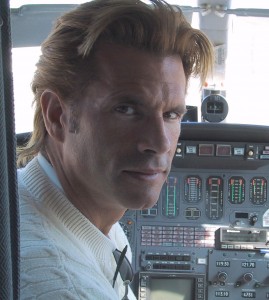 From 1992 through 1997, fans tuned in to “Renegade” to follow the exploits of Reno Raines, a detective-turned-fugitive. Following that hit series, Lorenzo Lamas was chosen for the starring role in two other action TV series, “Air America” and “The Immortal.” He’s also appeared in more than 50 films over the last 25 years; most have been in the action genre.
From 1992 through 1997, fans tuned in to “Renegade” to follow the exploits of Reno Raines, a detective-turned-fugitive. Following that hit series, Lorenzo Lamas was chosen for the starring role in two other action TV series, “Air America” and “The Immortal.” He’s also appeared in more than 50 films over the last 25 years; most have been in the action genre.
With that action-hero image in mind, as well as the knowledge that he’s a black belt in three different martial arts and a former race car driver who’s never without a Harley, when someone finds out he’s a pilot, the tendency is to think he got his pilot’s license for the thrill of it. But he says that’s not the case. It was a desire to spend quality time with his children that inspired the father of six to take up flying.
In 1996, Lamas was shooting “Renegade” in San Diego. At that time, his two oldest children, actor/model Alvaro Joshua (A.J.) and Shayne, were living in Lake Havasu, Ariz.
“In order to see them, they’d have to get on a commuter flight from Lake Havasu to Phoenix, then hop on a 737 to San Diego,” he said. “They’d basically have to miss a day of school in order to come out and visit me. I started thinking about getting a pilot’s license simply because I thought it would make better sense.”
He reasoned that if he had a pilot’s license, he could fly to Lake Havasu on a Friday afternoon, pick them up, fly back to San Diego, and have the entire weekend to spend with them.
“Instead of worrying about airplane reservations, I’d just have more time with them,” he said. “And we could spend the time in the airplane together, on the way to San Diego, and on the way back.”
Once Lamas began learning to fly, however, something happened that forced him to decide if he wanted to be a pilot or remain a race car driver.
Read more: Flying Just Makes Sense (But it’s Also a Lot of Fun) – By Di Freeze
Fascinated with Anything That Flies – Lee Lauderback
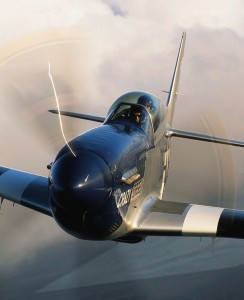 Lee Lauderback, the owner of Stallion 51, the world’s premier P-51 Mustang flight operation, says his father, a Navy pilot, was responsible for his early fascination with aviation. At age 10, Lauderback began flying gliders.
Lee Lauderback, the owner of Stallion 51, the world’s premier P-51 Mustang flight operation, says his father, a Navy pilot, was responsible for his early fascination with aviation. At age 10, Lauderback began flying gliders.
“Soaring was a major part of my life,” he said. “Starting at 14, I never really got away from sailplanes. I always had this intensity. When I got on the instructing side, I ended up buying a fiberglass sailplane called an Open Cirrus. I had that airplane for about six years and flew it maybe 600 hours. Then I bought an ASW20.”
He also progressed to powered aircraft, soloing on his 16th birthday. By then, his goal was to fly fighters in the military. But that didn’t happen, because he didn’t have 20/20 vision.
Instead, after graduating from college, he began flying corporate aircraft and did some charter work. In 1973, the 23-year-old pilot was flying for Lease a Plane, based in Denver, when he met Charlie Johnson, the chief pilot for Arnold Palmer. Johnson was looking for a copilot to take Palmer’s Lear 24 from Orlando Airport back to Latrobe, Penn.
“Charlie was an F-105 Air Force pilot,” Lauderback said. “We really hit it off. On the way up there, we had a great time; it wasn’t long before he said, ‘Can you do it again?’ It wasn’t very long from then that Charlie got me typed in a Learjet.”
Lauderback later became Palmer’s fulltime chief pilot. When Palmer, a pilot himself, bought an MD 500E in the mid-1980s, he subsidized Lauderback’s helicopter training.
“I went all the way through to instructor status in helicopters,” Lauderback said. “Then, I trained him in the helicopter.”
In 1987, Lauderback met Doug Schultz, an “aviation visionary” who was thinking about buying a dual-cockpit/dual-control TF-51 Mustang.
“It was the one we have today, which is now called ‘Crazy Horse,'” Lauderback said. “Nobody really wanted a dual-cockpit/dual-control airplane because it wasn’t a true fighter, but Doug committed to the airplane.”
In 1987, Lauderback sold his ASW20 sailplane and put that money into Stallion 51. At that time, he continued to work for Palmer, and flew the Mustang when he had time. But that would soon change.
To read more about the rise of Stallion 51, read Fascinated with Anything That Flies – By Di Freeze
Guts in the Sky As Well – Bob Lutz
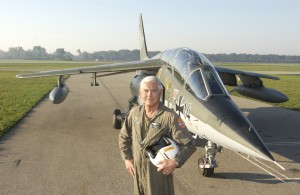 General Motors’ Bob Lutz says that throughout his career in the auto industry he’s been called a “car guy.” He said it hasn’t always been a positive label, but he at least came by it “honestly.” But Lutz is also a plane, helicopter and motorcycle guy—he’s really a “speed guy.”
General Motors’ Bob Lutz says that throughout his career in the auto industry he’s been called a “car guy.” He said it hasn’t always been a positive label, but he at least came by it “honestly.” But Lutz is also a plane, helicopter and motorcycle guy—he’s really a “speed guy.”
Lutz, a former Marine captain and jet attack pilot, who is also the author of “Guts: 8 Laws of Business from One of the Most Innovative Business Leaders of our Time,” says he “never fit into the standard mold too well.” He not only has flown his helicopter to work, but he also gets as many hours as he can in his Czech-built Aero Vodochody L-39 “Albatros” and his West German Dornier A model Alpha Jet. He bought the L-39 because he missed the “adrenaline rush” of military flying.
At one time, Lutz was intent on making the military his career, but needed a college degree to advance as an officer. So, while flying in the Reserve out of the Alameda Naval Air Station, he entered the University of California at Berkeley. While at Berkeley, Lutz made a different decision regarding his future. He found himself becoming “totally fascinated with the world of business, particularly the whole bundle of human psychological constructs involved in marketing.” He started thinking seriously about combining a career in business with his “second” burning passion in life—cars.
At age 29, Lutz received his bachelor’s degree in production management. Soon after also receiving an MBA, he got into the auto industry with a series of marketing and, later, management jobs.
While at Chrysler, Lutz dreamed up the Cobra-inspired Dodge Viper, which vastly affected the public image of the “dull, stodgy, beleaguered K-car” company. The retro car, the fastest and most expensive vehicle ever mass-produced in the United States, was brought to market in three years on a modest budget of $80 million. It became reality, with the help of Chrysler consultant Carroll Shelby, in 1992. Lutz said the Viper became a “potent symbol” of Chrysler’s new spirit, as well as its unconventional thinking and daring, and that the result was a beautiful example “of what can happen when the whole brain is engaged.”
To read more about Bob Lutz’ unconventional thinking, visit Bob Lutz: Guts in the Sky as Well – By Di Freeze











